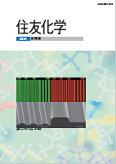FY 2020
2020.7.31 issue
-
Inpyrfluxam is a new succinate dehydrogenase inhibitor (SDHI) fungicide discovered by Sumitomo Chemical Co., Ltd. This compound shows robust activity against Asian soybean rust, apple scab and other important phytopathogenic fungi on various crops. Inpyrfluxam has good fungicidal properties, such as preventive efficacy, curative efficacy and translaminar activity. Inpyrfluxam also has safer profiles for human health and the environment. In Japan, a formulated product, KANAME® flowable, has been launched in 2020. Inpyrfluxam is under commercial development in many other countries, including Brazil, Argentina, the United States, Canada, Europe and South Korea.
(by Satoshi WATANABE, Yuichi MATSUZAKI, Hiroshi SAKAGUCHI, Fukumatsu IWAHASHI, Hideo KAWANAKA, Tadafumi MATSUNAGA, Miwa KONDO, Miho TABUCHI)
-
Alumina having a purity of 99.99% (4N) or more is classified as high purity alumina, and has been put into production using several manufacturing methods. Among them, Sumitomo’s high purity alumina is manufactured using the hydrolysis method of aluminium alkoxide, and the company has developed various high purity alumina powders to meet customer requirements and expand its business. This report outlines the features of high purity alumina and the development of new grades for future applications.
(by Shunsuke SAKAMOTO, Teppei KAJINO, Tomomichi NASU, Shota SAKAKI, Yoshiaki SAKATANI)
-
Blonanserin is an atypical antipsychotic drug with a high affinity and selectivity for dopamine D2, D3 and serotonin 5-HT2A receptors. Blonanserin transdermal patch, LONASEN Tape, is the first of its kind in the world for treatments indicating schizophrenia. Here, the authors report the background of starting development, patch formulation designs and results of clinical studies.
(by Izumi SASAKI, Masayasu TANAKA)
-
Gallium nitride (GaN) has been intensively studied for applications in various optical and electronic devices. In terms of the device fabrication process, etching technology is one of the most important factors affecting device performance. Generally, GaN is etched by inductively coupled plasma reactive ion etching, because it has excellent chemical stability. However, plasma can easily damage GaN surfaces. This report presents photoelectrochemical etching technology with simple set-up for damage-free GaN etching.
(by Fumimasa HORIKIRI, Noboru FUKUHARA, Masatomo SHIBATA)
-
Although the first MRL Directive was published in 1976, Community Maximum Residue Levels (MRLs) were set only for a limited number of pesticides until September 1, 2008. For some pesticides, different levels were established as national MRLs by the Member States, and for some pesticides no MRLs were set. Before September 1, 2008, there were four separate MRL Directives. The first one was published in 1976, the second and third ones were published in 1986, and the fourth one was published in 1990. Those four MRL Directives were replaced by the MRL Regulation published in 2005. The MRL Regulation did not only consolidate MRLs that appeared in the four MRL Directives, but it also established procedures and Annexes which were not included in the MRL Directives. This article summarizes the provisions introduced by the MRL Regulation and the changes on the procedures for setting/modifying MRLs.
(by Hiroko HARADA, Mio TATSU, Mika OTA)
